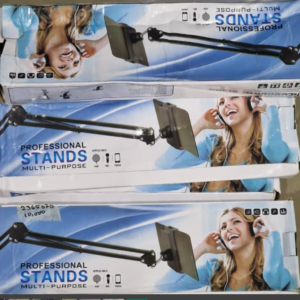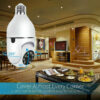HOW DOES LIGHT BULB CAMERA WORK? WORTHY TO KNOW.

INTRODUCTION
With the development of technology, surveillance cameras have become an essential part of our lives and help us keep an eye on our environment. Traditional surveillance cameras are often bulky and require extensive installation. However, a new innovative solution – the light bulb camera – has emerged. This unique device combines the functionality of a bulb with a hidden camera, allowing you to monitor any space discreetly without creating suspicion. In this article, we will explore how a bulb camera works, its components, the installation process, functionality, benefits, limitations, and tips to effectively use it.
HOW DOES A LIGHT BULB CAMERA WORK?
A light bulb camera is designed to seamlessly blend into any environment and provide surveillance capabilities. It functions as both an illumination source and a hidden camera. The clever design of the device allows it to capture video and audio discreetly without raising suspicion.
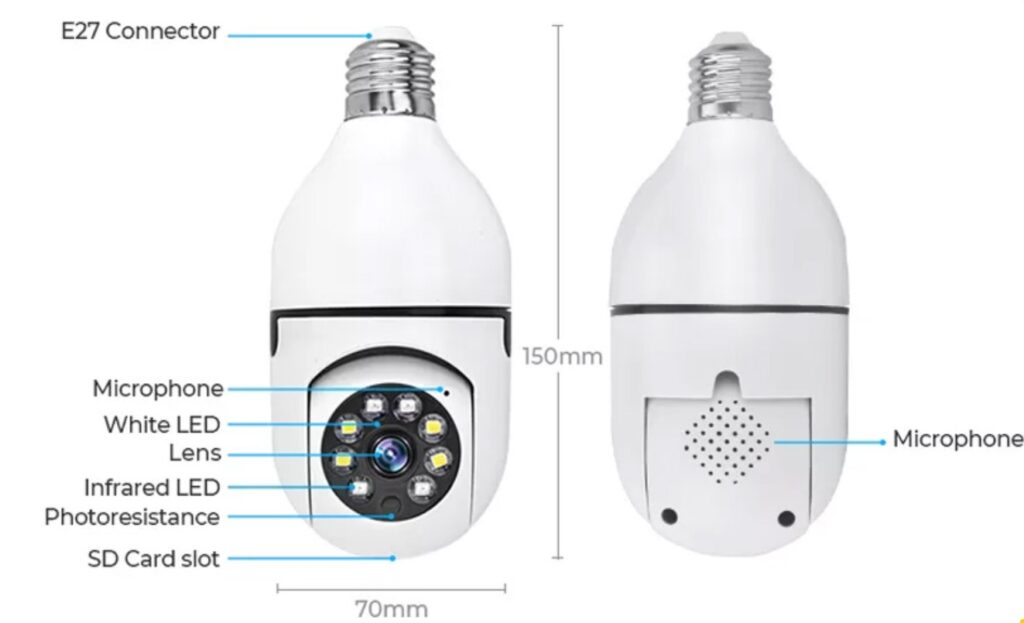
Light Bulb Cameras are usually equipped with a high-resolution camera sensor and a wide-angle lens. The camera sensor captures video, while the lens determines the field of view. The captured images are then processed and transmitted wirelessly to a connected device such as a smartphone or computer. One of the key features of a bulb camera is its ability to be remotely controlled. Users can access the camera’s live feed and recorded footage via a mobile application or dedicated web interface. This allows you to monitor and play recorded videos in real time from anywhere in the world with an Internet connection. Light bulb cameras are powered by existing electrical cables in the room. They are usually compatible with standard light sockets, making installation easy.
Once installed, the camera can be controlled, adjusted and adjusted by the accompanying mobile app or software. In order to ensure privacy and security, most light bulb cameras offer advanced features such as password protection, encrypted video transmission and multi-user access control. These safeguards help prevent unauthorized access to camera feed and keep the recorded recordings safe.
In addition, many bulb cameras are equipped with motion detection technology. When a movement is detected in the camera’s field of view, it triggers a warning on the connected device. This function is particularly useful for monitoring activity in the absence of the user and can be used as an effective security measure.
In summary, a light bulb camera combines the functionality of a traditional light bulb with a hidden surveillance camera. It captures video and audio discreetly, can be controlled remotely, and offers advanced features such as motion detection and privacy protection.
COMPONENTS OF A LIGHT BULB CAMERA
A light bulb camera consists of multiple components working together to provide surveillance capabilities disguised within a light bulb shape. Let’s explore the key components of a typical light bulb camera:
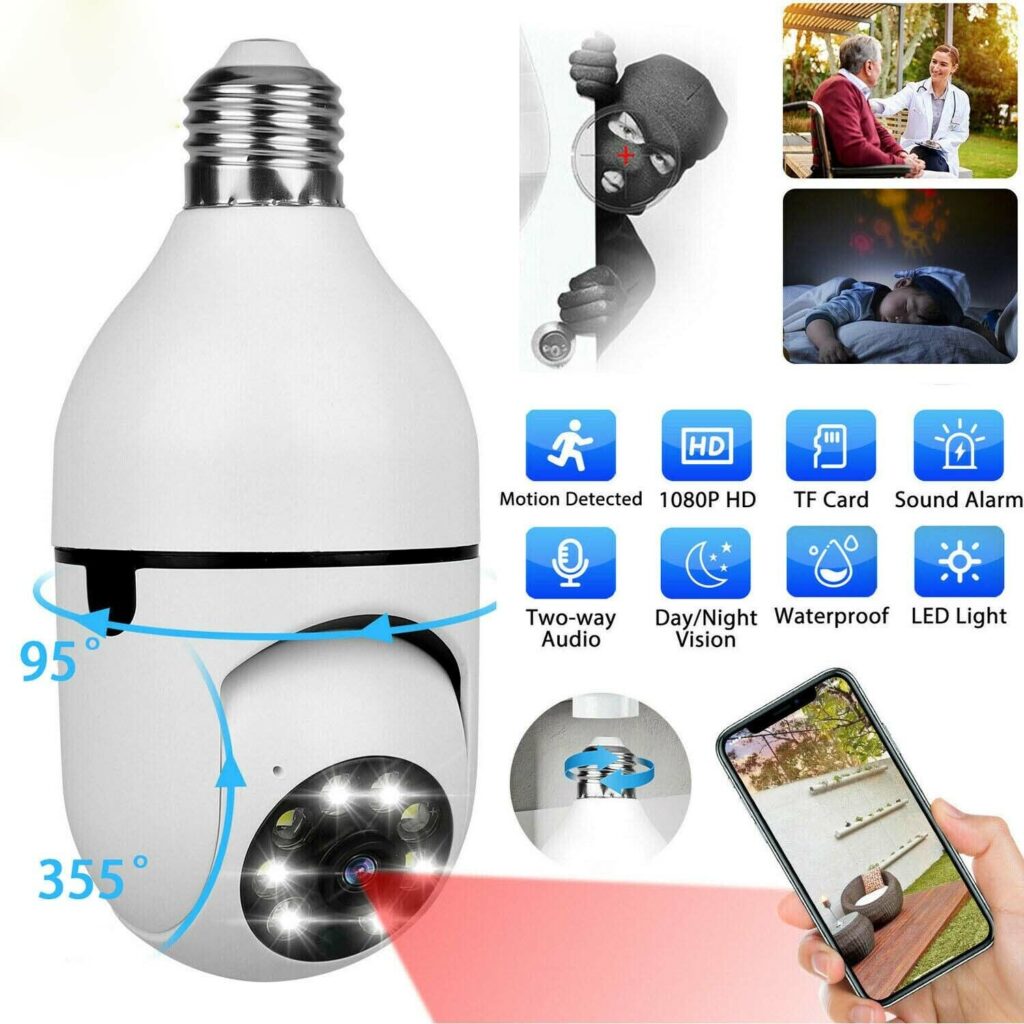
- Camera Sensor: The camera sensor is the heart of the light bulb camera. It captures high-resolution video footage, typically in HD or even 4K resolution, ensuring clear and detailed visuals.
- Wide-Angle Lens: The light bulb camera is equipped with a wide-angle lens, allowing it to capture a broad field of view. This ensures that a larger area can be monitored without the need for multiple cameras.
- LED Lights: The light bulb camera incorporates LED lights, providing illumination to the surroundings. These lights can be controlled and adjusted through the connected mobile app or software, allowing users to customize the brightness and colour temperature to their preference.
- Microphone: A built-in microphone enables the light bulb camera to capture audio along with the video footage. This feature allows for both visual and auditory surveillance, providing a more comprehensive monitoring solution.
- Image Processing Unit: The image processing unit is responsible for optimizing the captured video footage and enhancing its quality. It applies various filters, adjustments, and compression techniques to ensure clear and smooth playback of the recorded videos.
- Wireless Transmitter: The light bulb camera utilizes a wireless transmitter to transmit the captured video and audio footage to a connected device. This wireless connectivity allows for remote access and control of the camera’s feed.
- Power Supply: Like any traditional light bulb, a light bulb camera requires a power source to function. It is typically powered by the existing electrical wiring of the room, drawing electricity from the light bulb socket to operate both the camera and the LED lights.
These components work together seamlessly to provide surveillance capabilities in the form of a disguised light bulb. The integration of high-quality camera sensors, wide-angle lenses, LED lights, microphones, and wireless connectivity makes the light bulb camera an efficient and discreet monitoring solution.
INSTALLATION OF A LIGHT BULB CAMERA
The installation process of a light bulb camera is relatively straightforward and does not require extensive technical knowledge. Here are the steps to install a light bulb camera:
- Select the Location: Choose a suitable location for the light bulb camera installation. It should provide an optimal view of the area you wish to monitor while ensuring the camera remains inconspicuous.
- Turn Off the Power: Before starting the installation process, ensure that the power to the light fixture is turned off. This is essential for safety reasons and to avoid any electrical accidents during the installation.
- Remove the Existing Light Bulb: Unscrew and remove the existing light bulb from the light fixture. Keep in mind that the light bulb camera will replace the traditional light bulb, so you won’t be able to use it anymore for lighting purposes.
- Install the Light Bulb Camera: Screw the light bulb camera into the light fixture socket. Ensure that it is secured tightly, but be cautious not to over tighten it, as it may damage the camera or the socket.
- Connect to Power: Once the light bulb camera is installed, turn on the power to the light fixture. The camera will now receive power through the electrical wiring, allowing it to operate both the camera and the built-in LED lights.
- Download and Set Up the Mobile App: To access the live feed and control the light bulb camera remotely, download the dedicated mobile app or software provided by the camera manufacturer. Follow the instructions to set up the app and connect it to the camera.
- Connect to Wi-Fi: Use the app to connect the light bulb camera to your home or office Wi-Fi network. This step is necessary for the camera to transmit the video feed wirelessly to your connected device.
- Configure Camera Settings: Adjust the camera settings according to your preference using the mobile app or software. You can customize features such as motion detection sensitivity, recording options, and notification settings.
- Test and Monitor: Once the installation and configuration are complete, test the light bulb camera by accessing the live feed on your connected device. Ensure that the camera is capturing clear video footage and that all features are functioning as expected.
It is important to carefully follow the manufacturer’s instructions provided with the light bulb camera for a successful installation. If you encounter any difficulties or have questions, refer to the user manual or contact the manufacturer’s customer support for assistance.
FUNCTIONS OF A LIGHT BULB CAMERA
A light bulb camera offers a range of features and functionalities that make it a versatile surveillance device. Let’s explore the key functionalities of a typical light bulb camera:
- Real-Time Monitoring: One of the primary functions of a light bulb camera is its ability to provide real-time monitoring. Users can access the live video feed from the camera through a connected device such as a smartphone, tablet, or computer. This allows for immediate and remote monitoring of the designated area.
- Video Recording: Light bulb cameras have built-in storage options, such as an SD card slot or cloud storage, enabling them to record video footage. Users can set the camera to continuously record or trigger recording when motion is detected within its field of view. Recorded videos can later be reviewed or downloaded for evidence if needed.
- Motion Detection: Many light bulb cameras come equipped with motion detection technology. When motion is detected within the camera’s field of view, it can send instant notifications to the connected device. This feature allows users to be alerted of any activity or potential intrusions even when they are not actively monitoring the camera.
- Two-Way Audio: Some light bulb cameras offer the convenience of two-way audio communication. This means that users can not only listen to the audio captured by the camera but also communicate through the built-in microphone and speaker. This functionality can be useful for interacting with people in the monitored area or deterring potential threats.
- Night Vision: To ensure surveillance capability in low-light or dark conditions, light bulb cameras are often equipped with infrared or night vision technology. This allows the camera to capture clear video footage even in complete darkness, providing enhanced security during nighttime hours.
- Mobile App Control: Light bulb cameras can be controlled and managed through a dedicated mobile app. The app offers features such as live video streaming, playback of recorded footage, customizable camera settings, and alerts and notifications. Users can access and control the camera from anywhere using their smartphone or tablet.
- Compatibility with Smart Home Systems: Many light bulb cameras are compatible with popular smart home systems, such as Amazon Alexa or Google Assistant. This integration allows users to control the camera through voice commands and incorporate it into their smart home automation routines.
- Multiple User Access: Light bulb cameras often support multiple user access, allowing several individuals to monitor the camera simultaneously. This can be useful for households or businesses with multiple users who need access to the camera’s feed and recordings.
- Privacy and Security: Light bulb cameras prioritize privacy and security by offering features such as password protection, encrypted video transmission, and secure cloud storage. These measures ensure that the camera feed and recorded footage remain confidential and protected from unauthorized access.
The functionality of a light bulb camera makes it a versatile surveillance tool, providing real-time monitoring, video recording, motion detection, two-way audio, night vision capability, mobile app control, and compatibility with smart home systems. These features combine to offer enhanced security and peace of mind for both residential and commercial applications.
BENEFITS OF USING A LIGHT BULB CAMERA
Using a light bulb camera as a surveillance solution offers a range of benefits for both residential and commercial settings. Let’s explore some of the key advantages of using a light bulb camera:
- Discreet Monitoring: One of the biggest advantages of a light bulb camera is its discreet nature. It blends seamlessly into the environment, making it difficult for intruders or unauthorized individuals to identify it as a surveillance device. This allows for covert monitoring without raising suspicion.
- Easy Installation: Installing a light bulb camera is simple and hassle-free. It can be conveniently screwed into a standard light bulb socket, eliminating the need for complex wiring or extensive installation work. This makes it a cost-effective and time-saving surveillance option.
- Remote Access and Control: Light bulb cameras can be accessed and controlled remotely through a connected device, such as a smartphone or computer. This enables users to monitor the camera’s feed in real-time, review recorded footage, and adjust camera settings from anywhere with an internet connection.
- 24/7 Surveillance: With the inclusion of night vision and motion detection technology, light bulb cameras provide continuous surveillance even during low-light conditions or at night. This ensures that the monitored area is protected around the clock, offering enhanced security and peace of mind.
- Cost-Effective Solution: Light bulb cameras serve a dual purpose by providing both surveillance and lighting capabilities in a single device. This eliminates the need for separate lighting fixtures and dedicated surveillance cameras, saving both money and space.
- Flexible Placement: Light bulb cameras can be positioned in various locations within a room to capture the desired field of view. Their compact design allows for flexibility in placement, ensuring optimal surveillance coverage without obstructing the overall aesthetics of the space.
- Customizable Settings: Light bulb cameras offer customizable settings and features to meet specific surveillance requirements. Users can adjust camera angles, motion detection sensitivity, recording options, and other settings to cater to their individual needs.
- Deterrent Effect: The presence of a visible light bulb camera or the knowledge of its existence can act as a deterrent for potential intruders or criminals. The fear of being recorded can discourage unauthorized activities and enhance the overall security of the premises.
- Multiple Use Cases: Light bulb cameras are not limited to security purposes. They can also be used for monitoring pets, children, elderly family members, or employees in a workplace. This versatility makes them a valuable tool for a variety of surveillance needs.
The benefits of using a light bulb camera make it an attractive choice for those seeking a discreet, easy-to-install, and versatile surveillance solution. With features such as remote access, continuous monitoring, cost-effectiveness, and customizable settings, light bulb cameras provide enhanced security and peace of mind.
Limitations of a Light Bulb Camera
While light bulb cameras offer several advantages, they also have certain limitations to consider. Understanding these limitations can help users make informed decisions about their surveillance needs. Let’s explore some of the common limitations of a light bulb camera:
- Limited Field of View: Light bulb cameras typically have a fixed wide-angle lens that provides a broad field of view. However, this may result in some blind spots or areas not fully captured by the camera. It is important to strategically position the camera for optimal coverage.
- Dependence on Power Supply: Light bulb cameras rely on a stable power supply to operate. In the event of a power outage, the camera may stop functioning until power is restored. It is essential to have a backup power source or alternative surveillance measures in place to ensure uninterrupted monitoring.
- Limited Lighting Options: Light bulb cameras provide illumination through built-in LED lights. While they offer basic lighting functionality, they may not sufficiently illuminate larger areas or provide customizable lighting options like traditional light fixtures.
- Dependent on Wi-Fi Connection: Light bulb cameras require a stable Wi-Fi connection to transmit the video feed and enable remote access. If the Wi-Fi signal is weak or unstable, it may result in poor video quality, lagging, or loss of connection. A strong and reliable Wi-Fi network is crucial for optimal performance.
- Reliability on Mobile App or Software: Light bulb cameras rely on a dedicated mobile app or software for control and navigation. If the app or software experiences bugs, compatibility issues, or becomes out-of-date, it may affect the camera’s functionality and user experience. Regular updates and maintenance are necessary for smooth operation.
- Privacy Concerns: As with any surveillance device, there are privacy concerns associated with light bulb cameras. Depending on local laws and regulations, it is important to be aware of the legal implications of monitoring in certain areas or recording without consent. Respecting privacy rights and establishing clear guidelines is crucial.
- Limited Storage Capacity: Light bulb cameras often come with limited internal storage or require additional storage solutions, such as SD cards or cloud storage subscriptions, for recorded footage. Users need to manage and regularly review storage capacity to ensure uninterrupted recording and avoid loss of important footage.
- Integration with Other Security Systems: Light bulb cameras may have limitations when it comes to integration with other security systems or smart home automation. Compatibility issues or limited functionalities may arise when trying to connect the light bulb camera with existing security devices or software.
Considering these limitations, it is essential to assess your specific surveillance requirements and evaluate whether a light bulb camera can adequately meet your needs. Understanding these limitations will help you make an informed decision and implement additional measures if necessary.
TIPS FOR USING A LIGHT BULB CAMERA
Using a light bulb camera effectively requires proper setup and usage. Here are some useful tips to enhance your experience and maximize the benefits of your light bulb camera:
- Strategic Placement: Position the light bulb camera in a location that provides optimal coverage of the area you want to monitor. Consider factors such as the camera’s field of view, height, and any potential obstructions that may obstruct the view.
- Secure Wi-Fi Connection: Ensure that your light bulb camera is connected to a secure and reliable Wi-Fi network. This will help prevent unauthorized access to the camera feed and ensure a stable connection for remote access and control.
- Regular Maintenance: Perform regular maintenance on your light bulb camera, including checking for updates to the mobile app or software, cleaning the lens, and ensuring the camera is securely fastened in its socket.
- Adjust Camera Settings: Customize the camera settings to fit your specific needs. This may include adjusting the motion detection sensitivity, setting recording options, enabling or disabling sound recording, and configuring notification preferences.
- Manage Storage: Keep track of the storage capacity on your light bulb camera, whether it is inbuilt or using external storage options. Regularly review and delete unnecessary footage to ensure that you don’t run out of storage space when you need it the most.
- Test Motion Detection: Test the motion detection feature of your light bulb camera to ensure it captures the movements you want to monitor. Adjust the sensitivity settings if necessary to avoid false alerts while ensuring important events are detected.
- Review Privacy Laws: Familiarize yourself with local privacy laws and regulations to ensure that you are using the light bulb camera within legal boundaries. Understand your rights and responsibilities regarding consent, recording in public areas, and respecting others’ privacy.
- Regularly Check Camera Feed: Take the time to periodically check the live feed from your light bulb camera to ensure that it is functioning properly and capturing high-quality video footage. Regular monitoring allows you to address any issues promptly.
- Communicate Transparently: If you are using a light bulb camera in a shared space or a workplace, communicate transparently with others about its presence. This fosters trust and maintains respectful privacy expectations among all individuals in the area.
- Consult the User Manual: Refer to the user manual provided by the manufacturer for specific instructions and troubleshooting tips. It is always beneficial to have a clear understanding of the camera’s features, limitations, and recommended best practices.
By applying these tips, you can optimize the usage of your light bulb camera and ensure that it functions reliably to meet your surveillance needs. Remember to stay vigilant and respectful of privacy while using the camera to maintain a safe and secure environment.
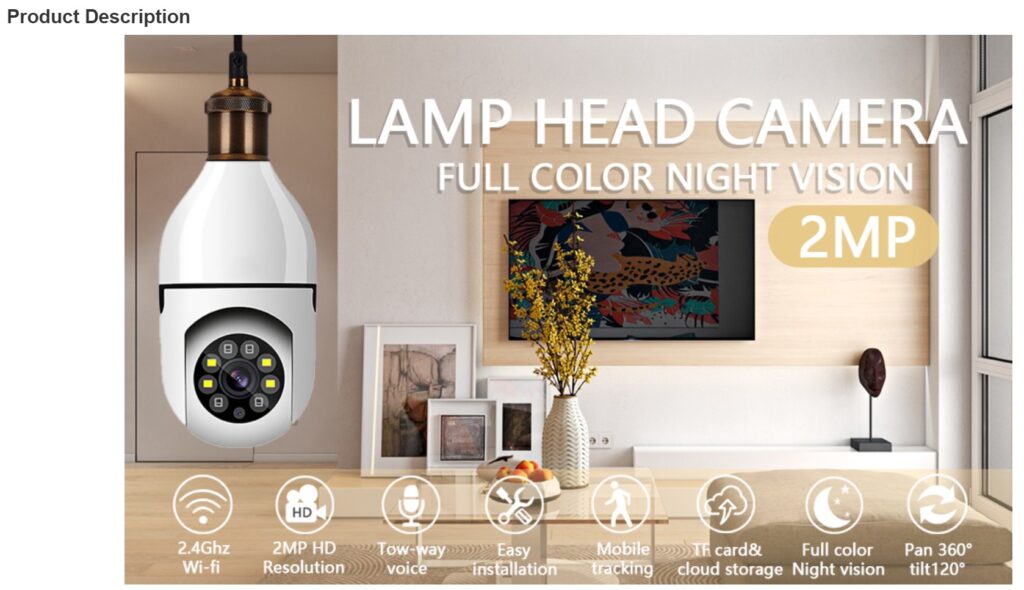
CONCLUSION
Light bulb cameras have revolutionized the world of surveillance by combining the functionality of a light bulb with discreet monitoring capabilities. With their easy installation, remote access, motion detection, and other advanced features, these cameras offer a practical and versatile solution for both residential and commercial environments.
In this article, we explored how a light bulb camera works, its components, installation process, functionality, benefits, limitations, and tips for usage. Light bulb cameras provide real-time monitoring, video recording, motion detection, two-way audio, night vision, and flexible placement options. They offer several benefits, such as discreet surveillance, easy installation, remote access, continuous monitoring, cost-effectiveness, and customizable settings.
However, it is essential to be aware of the limitations of light bulb cameras, including their limited field of view, dependence on power supply and Wi-Fi connection, and privacy concerns. Understanding these limitations allows users to make informed decisions and implement additional measures if needed.
By following the provided tips, users can optimize the usage of their light bulb cameras. Strategic placement, secure Wi-Fi connection, regular maintenance, and adjusting camera settings are essential practices to enhance the camera’s performance. Additionally, understanding privacy laws, regularly checking the camera feed, and transparent communication contribute to responsible and respectful usage.
In conclusion, light bulb cameras offer a unique and innovative way to incorporate surveillance into our daily lives. By leveraging these devices’ capabilities and implementing the best practices discussed in this article, users can enjoy enhanced security, peace of mind, and seamless monitoring of their surroundings.
Click here to buy your quality bulb camera now and enjoy discount price.

